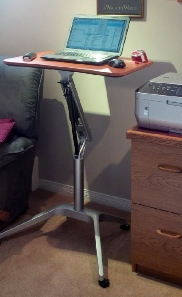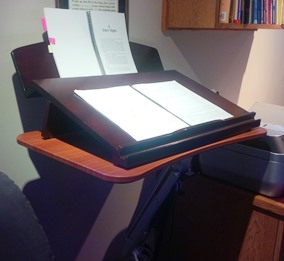There are many editing and plain language conferences planned this year.
Get up, stand up
 I love my work…except when I don’t.
I love my work…except when I don’t.
I love that I get paid to read, to work with words, and to collaborate with talented professionals to produce something meaningful.
I love the tactile component of editing: consulting reference books, working with pen and paper (yes, that is still part of the job), or typing on my keyboard. And, like most editors, I am content to spend most of my work hours in solitude, without having to leave my desk for long stretches at a time.
But that is also the part I don’t love. The long stretches of inactivity.
By now, the pronouncement that “sitting is the new smoking” is old news. The Mayo Clinic is just one of myriad credible sources that summarizes the risks of too much sitting, but for me, the science just confirmed what common sense told me long ago.
I’ve always been active, and part of my daily routine is getting significant exercise: running, bicycling, playing soccer, swimming laps, working out in the gym. A day without a workout doesn’t feel right to me, and being fit is very much a part of my identity. Yeah…staying fit to stay healthy is a lot of it, but I just like to move—fast, and a lot, and if competition is involved, then it’s even better.
But my need to move doesn’t fit well with the demands of editing (although I do believe that some of my best thinking on how to solve structural puzzles in documents has happened while swimming laps). And as I entered middle age, the sitting-down part of the job increasingly distressed me; my “desk restlessness” was interfering with my concentration.
I tried all the “tricks”: walking around my office while talking on the phone with a client; taking a break every hour to run up and down a flight of stairs; deliberately moving reference books away from my computer screen so I would have to stand up to fetch them. It wasn’t enough. I knew I needed something else—either a new career as a postie or a new way to work.
Enter the standing desk.
I recently purchased an alternative work surface, one of the many models available that allows you to work while standing. Having already invested in substantial built-in workspace in my home office, which I wasn’t prepared to undo, I found a good fit with Levenger’s Sit-to-Stand Rolling Workstation. It has transformed my work routine.
The workstation, large enough for my laptop and then some, is where I begin my day, responding to emails and setting my priorities for the hours ahead. While standing, I often find myself swinging my legs or dancing in place. If I’m working with hard copy, the work surface accommodates my proofreader’s desktop, which allows me to maintain good neck posture while reading. A bonus is that the workstation is adjustable in height and is on wheels, so on nice summer days I can wheel it out to my patio and edit in the sunshine, standing or sitting.
 I don’t stand all day. If I want my big screen, I return to my regular desk, which I now consider as taking a break from standing. And my standing desk certainly doesn’t diminish my need and desire for daily exercise, but it sure beats sitting down on the job. Or becoming a postie.
I don’t stand all day. If I want my big screen, I return to my regular desk, which I now consider as taking a break from standing. And my standing desk certainly doesn’t diminish my need and desire for daily exercise, but it sure beats sitting down on the job. Or becoming a postie.
Comments (1)
Comments are closed.




I too switched to a standing desk earlier this year for exactly the same reasons, and I love it! It took a few days to get used to, but I now find I am less tired at the end of the day and less likely to succumb to a sleepy time about 2 p.m. And bonus: my middle-age (OK, well more than middle age: I doubt I’ll live to 120) spread seems to have halted. I googled “inexpensive standing desks” and spent about $30 at IKEA transforming a section of my desk into a standing one. I do the opposite though: My workstation is a standing one and I sit down to use the laptop or proofread at my editor’s desk. Hmmm, I love just about everything Levenger though.